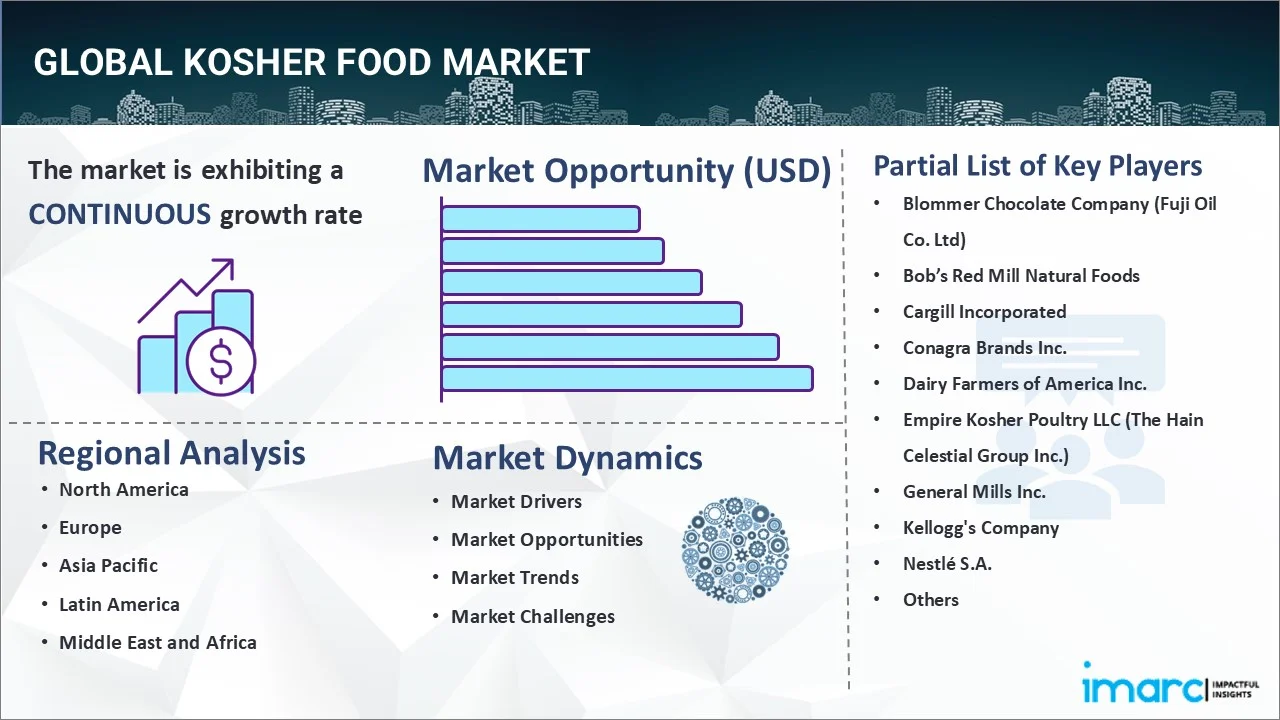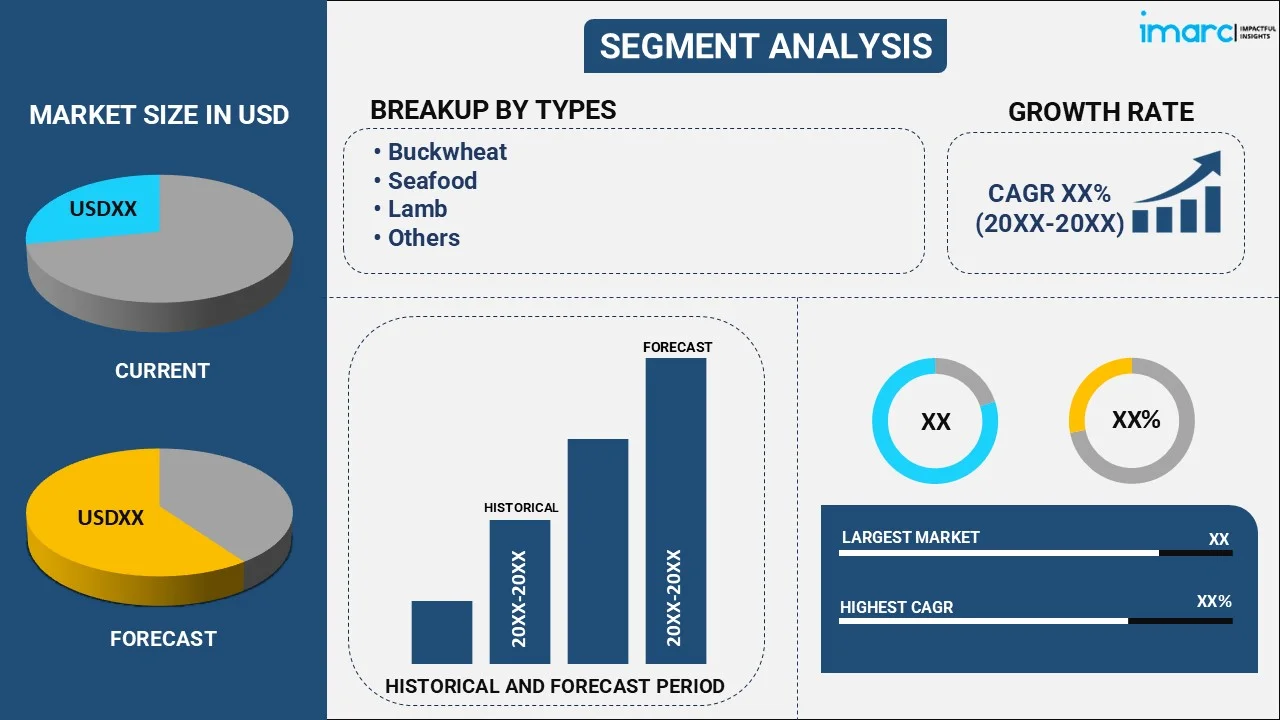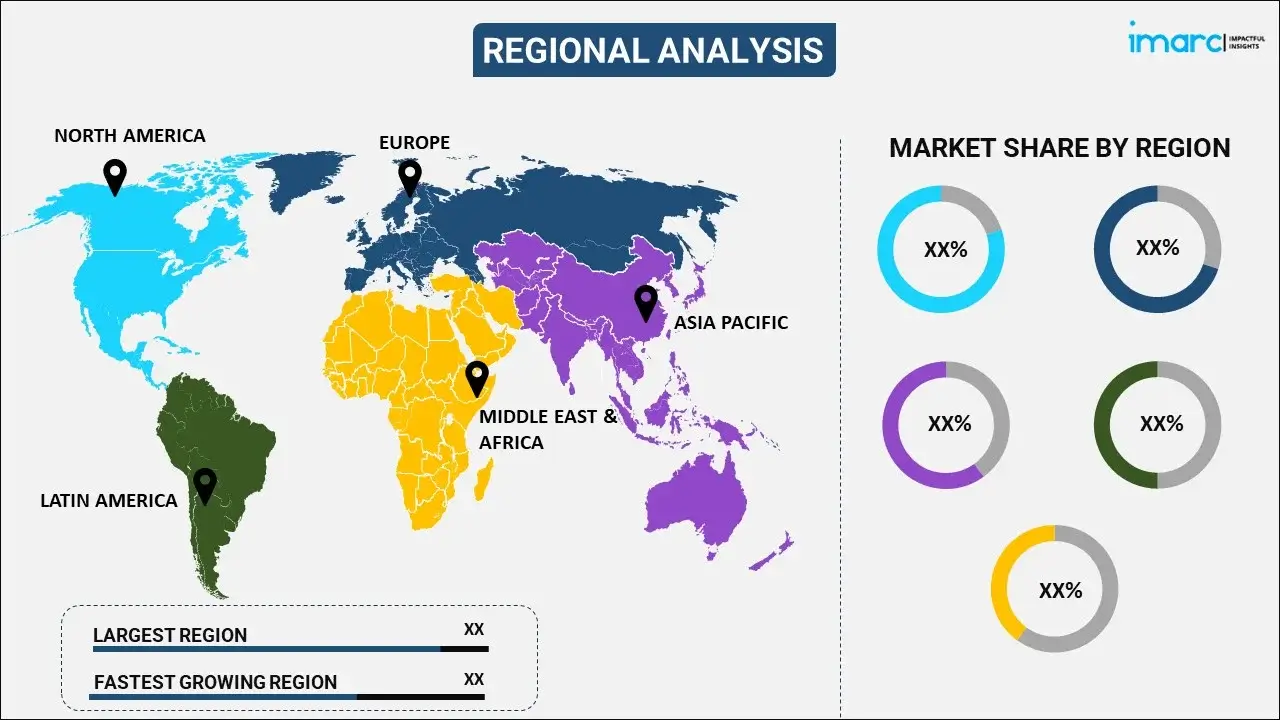
Kosher Food Market Report by Type (Buckwheat, Seafood, Lamb, Pulses, and Others), Application (Culinary Products, Snacks and Savory, Bakery and Confectionery Products, Meat, Beverages, Dietary Supplements), Distribution Channel (Supermarkets and Hypermarkets, Grocery Stores, Online Stores), and Region 2025-2033
Market Overview:
The global kosher food market size reached USD 22.1 Billion in 2024. Looking forward, IMARC Group expects the market to reach USD 29.6 Billion by 2033, exhibiting a growth rate (CAGR) of 2.95% during 2025-2033. The increasing governments regulations promoting transparency in food labeling, the rising food safety and traceability concerns, the impact of religious organizations endorsing kosher products, and the kosher certification's potential boost to export markets are some of the factors propelling the market demand.
|
Report Attribute
|
Key Statistics
|
|---|---|
|
Base Year
|
2024 |
|
Forecast Years
|
2025-2033
|
|
Historical Years
|
2019-2024
|
| Market Size in 2024 | USD 22.1 Billion |
| Market Forecast in 2033 | USD 29.6 Billion |
| Market Growth Rate (2025-2033) | 2.95% |
Kosher Food Market Analysis:
- Market Growth and Size: The global kosher food market is experiencing steady growth, driven by factors like the increasing consumer demand for quality and authentic kosher-certified products.
- Major Market Drivers: Key drivers include the stringent regulations for kosher certification, which ensure food safety and quality, appealing to a broader consumer base beyond the Jewish population. The market is also propelled by the expanding availability of kosher products across various retail formats, making them more accessible to a wider audience.
- Key Market Trends: There is a noticeable trend in the integration of organic, non-genetically modified organism (GMO), and healthy ingredients in kosher food products, catering to the increasing consumer demand for healthier eating options. Additionally, innovative product offerings and the diversification of kosher food in terms of variety and cuisine are trending, meeting the sophisticated palates of modern consumers.
- Geographical Trends: North America dominates the market, driven by the rising health consciousness among the masses. However, Asia Pacific is emerging as a fast-growing market on account of the increasing awareness and acceptance of kosher-certified products among the masses.
- Competitive Landscape: The market is characterized by a mix of large multinational corporations and small to medium-sized enterprises (SMEs), each contributing to the competitive dynamics. Companies are increasingly focusing on certification, transparent labeling, and broadening their product portfolios to cater to the diverse needs of consumers, thereby intensifying the market competition.
- Challenges and Opportunities: Challenges include the complexity and cost of obtaining kosher certification, along with ensuring consistent supply chain compliance. Nonetheless, opportunities for market players to innovate in product traceability and supply chain transparency and to expand into untapped markets are projected to overcome these challenges.

Kosher Food Market Trends/Drivers:
Increasing prevalence of lactose intolerance among the masses
The increasing prevalence of lactose intolerance among the masses is stimulating the market. Lactose intolerance, the inability to digest lactose found in dairy products, has prompted individuals to seek alternatives that cater to their dietary needs. Kosher food, often requiring the separation of dairy and meat products, inherently provides a solution for those with lactose intolerance by offering a range of dairy-free and pareve (neutral) options. As awareness about lactose intolerance spreads, more consumers are drawn to kosher products that align with their dietary restrictions. The product's emphasis on label transparency and clear differentiation between dairy and non-dairy products resonates with those seeking lactose-free options. Manufacturers are responding to this demand by developing an array of lactose-free kosher products, including plant-based alternatives, which cater to a wider consumer base. The convergence of lactose intolerance concerns and kosher food practices contributes to the market's expansion, catering to both religious observance and dietary preferences.
Rising product demand among non-Jewish consumers
The rising product demand among non-Jewish consumers is bolstering the market. Beyond its traditional religious context, kosher certification is increasingly sought after by individuals who view it as a mark of quality, safety, and ethical standards. The meticulous regulations and supervision associated with kosher food resonate with a broader consumer base, encompassing diverse dietary preferences, including vegetarian, vegan, and allergen-free diets. Non-Jewish consumers are drawn to kosher products due to their perceived adherence to strict guidelines, traceability, and the avoidance of certain additives or ingredients. As health-conscious and ethically-minded consumers seek transparency in their food choices, kosher certification provides assurance. Manufacturers recognize this trend and are expanding their offerings to cater to the preferences of non-Jewish consumers, effectively driving the growth of the market beyond its traditional boundaries.
Growing consumer demand for ethically and locally sourced ingredients
The growing consumer demand for ethically and locally sourced ingredients is fostering the market. Kosher certification aligns well with these preferences, as it often involves meticulous scrutiny of supply chains and production processes. Consumers seeking transparency in sourcing, fair labor practices, and sustainable agriculture find value in kosher products that adhere to these principles. The product's emphasis on quality, traceability, and ethical considerations resonates with the ethos of sourcing ingredients responsibly. As consumers increasingly prioritize knowing where their food comes from and how it's produced, kosher certification provides a recognizable assurance standard. Manufacturers respond by partnering with suppliers who share these values and by expanding their portfolio of kosher-certified products. This alignment with ethical and locally sourced ingredients attracts health-conscious and socially aware consumers and stimulates the kosher food market growth by catering to evolving dietary and ethical preferences.
Kosher Food Industry Segmentation:
IMARC Group provides an analysis of the key trends in each segment of the global kosher food market report, along with forecasts at the global, regional and country levels from 2025-2033. Our report has categorized the market based on type, application and distribution channel.
Breakup by Type:

- Buckwheat
- Seafood
- Lamb
- Pulses
- Others
The report has provided a detailed breakup and analysis of the market based on the type. This includes buckwheat, seafood, lamb, pulses, and others.
Buckwheat has gained traction due to its versatile nature as a gluten-free alternative and its inclusion in kosher-friendly recipes. Its nutritional benefits and rising popularity among health-conscious consumers have fueled its market share.
Seafood appeals to kosher consumers due to its health benefits and being a staple in Jewish culinary traditions. The growth of sustainably sourced kosher seafood options has further bolstered its market expansion, appealing to environmentally conscious consumers.
Lamb has grown within the kosher food market due to its significance in various Jewish festivals and occasions. Its unique flavor profile and adaptability in kosher recipes have contributed to its market rise as consumers seek diverse options beyond traditional choices.
Breakup by Application:
- Culinary Products
- Snacks and Savory
- Bakery and Confectionery Products
- Meat
- Beverages
- Dietary Supplements
Meat dominates the market
The report has provided a detailed breakup and analysis of the market based on the application. This includes culinary products, snacks and savory, bakery and confectionery products, meat, beverages, and dietary supplements. According to the report, meat represented the largest segment.
Meat has emerged as a pivotal driver of growth in the kosher food market due to its cultural, religious, and culinary significance. The meticulous kosher slaughtering process, known as shechita, assures consumers of its adherence to Jewish dietary laws, enhancing its appeal among observant Jews. Additionally, meat is central in traditional Jewish meals and festivals, stimulating consistent demand.
The increasing availability of a diverse range of kosher-certified meats, including beef, poultry, and exotic options, has broadened consumer choices, attracting a wider demographic. Moreover, the growth of online platforms and global distribution networks has facilitated easier access to kosher meat products, bridging geographical gaps.
As the kosher food market expands beyond religious boundaries, the meat segment's prominence persists, driven by its cultural resonance, religious observance, and evolving consumer preferences for quality, traceability, and ethical sourcing.
Breakup by Distribution Channel:
- Supermarkets and Hypermarkets
- Grocery Stores
- Online Stores
Supermarkets and hypermarkets dominate the market
The report has provided a detailed breakup and analysis of the market based on distribution channel. This includes supermarkets and hypermarkets, grocery stores, and online stores. According to the report, supermarkets and hypermarkets represent the largest segment.
Supermarkets and hypermarkets play a catalytic role in propelling the kosher food market growth. Their extensive reach, diverse product offerings, and convenience have significantly expanded the accessibility of kosher products to a broader consumer base.
These retail giants dedicate specialized sections or aisles exclusively for kosher products, catering to Jewish and non-Jewish consumers seeking quality-assured and culturally sensitive food choices. This strategic placement enhances the visibility and awareness of kosher offerings.
Furthermore, the global presence of supermarkets and hypermarkets ensures that kosher products can reach markets locally and internationally, addressing the demands of Jewish communities worldwide. The convenience of one-stop shopping, combined with diverse kosher options, empowers consumers to incorporate kosher choices seamlessly into their shopping routines.
Breakup by Region:

- North America
- United States
- Canada
- Asia-Pacific
- China
- Japan
- India
- South Korea
- Australia
- Indonesia
- Others
- Europe
- Germany
- France
- United Kingdom
- Italy
- Spain
- Russia
- Others
- Latin America
- Brazil
- Mexico
- Others
- Middle East and Africa
North America exhibits a clear dominance, accounting for the largest market share
The report has also provided a comprehensive analysis of all the major regional markets, which include North America (the United States and Canada); Asia Pacific (China, Japan, India, South Korea, Australia, Indonesia, and others); Europe (Germany, France, the United Kingdom, Italy, Spain, Russia, and others); Latin America (Brazil, Mexico, and others); and the Middle East and Africa. According to the report, North America accounted for the largest kosher food market share.
North America has emerged as a significant growth driver in the market. The region's diverse population, including a substantial Jewish community, fuels the kosher food market demand, aligning with dietary and cultural preferences.
The presence of kosher-certified offerings in mainstream supermarkets and specialty stores across the continent has increased accessibility for Jewish and non-Jewish consumers, expanding the market's reach. Moreover, the proactive engagement of food manufacturers and producers in obtaining kosher certifications to tap into this consumer base further offers a favorable kosher food market outlook.
Additionally, the region's innovative food industry continually introduces new kosher options, ranging from traditional favorites to contemporary trends. This dynamic landscape resonates with a broader audience seeking quality, authenticity, and transparency in food choices. The region's trendsetter role and commitment to catering to diverse dietary needs solidify its pivotal contribution to the expanding kosher food market.
Competitive Landscape:
Top companies are vital in strengthening the market's growth through their strategic efforts and industry leadership. They prioritize innovation in product development, introducing a diverse range of kosher-certified offerings that cater to evolving consumer preferences, including dietary restrictions, ethical considerations, and health-conscious choices. These companies collaborate with reputable kosher certifying agencies to ensure the highest standards of compliance and transparency in their products. Moreover, top players actively engage with consumers through educational campaigns, highlighting the benefits of kosher certification beyond religious observance. They leverage their brand reputation to resonate with a broader audience, including health-focused, eco-conscious, and socially responsible consumers. Through partnerships with retailers, online platforms, and distribution networks, top kosher food companies amplify their market reach, making their products easily accessible to diverse demographics. By embodying innovation, quality, and ethical sourcing, these companies contribute significantly to the market's growth while driving a paradigm shift in how kosher food is perceived and consumed.
The report has provided a comprehensive analysis of the competitive landscape in the kosher food market. Detailed profiles of all major companies have also been provided.
- Blommer Chocolate Company (Fuji Oil Co. Ltd)
- Bob’s Red Mill Natural Foods
- Cargill Incorporated
- Conagra Brands Inc.
- Dairy Farmers of America Inc.
- Empire Kosher Poultry LLC (The Hain Celestial Group Inc.)
- General Mills Inc.
- Kellogg's Company
- Nestlé S.A.
- PepsiCo Inc.
- The Kraft Heinz Company
Recent Developments:
- In June 2020, Fuji Oil Holdings and its subsidiary Blommer Chocolate Company launched new initiatives to strengthen cocoa sustainability.
- In April 2021, Bob's Red Mill announced that it is expanding beyond the baking and cereal aisles and into the snacking segment by launching a new line of Oat Crackers.
- In July 2023, Cargill Incorporated and John Deere announced a collaborative effort to streamline the digital and in-field experience for farmers using John Deere technology and electing to participate in the Cargill RegenConnect program.
Kosher Food Market Report Scope:
| Report Features | Details |
|---|---|
| Base Year of the Analysis | 2024 |
| Historical Period | 2019-2024 |
| Forecast Period | 2025-2033 |
| Units | Billion USD |
| Scope of the Report | Exploration of Historical and Forecast Trends, Industry Catalysts and Challenges, Segment-Wise Historical and Predictive Market Assessment:
|
| Types Covered | Buckwheat, Seafood, Lamb, Pulses, Others |
| Applications Covered | Culinary Products, Snacks and Savory, Bakery and Confectionery Products, Meat, Beverages, Dietary Supplements |
| Distribution Channels Covered | Supermarkets and Hypermarkets, Grocery Stores, Online Stores |
| Regions Covered | Asia Pacific, Europe, North America, Latin America, Middle East and Africa |
| Countries Covered | United States, Canada, Germany, France, United Kingdom, Italy, Spain, Russia, China, Japan, India, South Korea, Australia, Indonesia, Brazil, Mexico |
| Companies Covered | Blommer Chocolate Company (Fuji Oil Co. Ltd), Bob’s Red Mill Natural Foods, Cargill Incorporated, Conagra Brands Inc., Dairy Farmers of America Inc., Empire Kosher Poultry LLC (The Hain Celestial Group Inc.), General Mills Inc., Kellogg's Company, Nestlé S.A., PepsiCo Inc., The Kraft Heinz Company etc. |
| Customization Scope | 10% Free Customization |
| Post-Sale Analyst Support | 10-12 Weeks |
| Delivery Format | PDF and Excel through Email (We can also provide the editable version of the report in PPT/Word format on special request) |
Key Questions Answered in This Report:
- How has the global kosher food market performed so far, and how will it perform in the coming years?
- What are the drivers, restraints, and opportunities in the global kosher food market?
- What is the impact of each driver, restraint, and opportunity on the global kosher food market?
- What are the key regional markets?
- Which countries represent the most attractive kosher food market?
- What is the breakup of the market based on the type?
- Which is the most attractive type in the global kosher food market?
- What is the breakup of the market based on the application?
- Which is the most attractive application in the global kosher food market?
- What is the breakup of the market based on the distribution channel?
- Which is the most attractive distribution channel in the global kosher food market?
- What is the competitive structure of the global kosher food market?
- Who are the key players/companies in the global kosher food market?
Key Benefits for Stakeholders:
- IMARC’s report offers a comprehensive quantitative analysis of various market segments, historical and current market trends, kosher food market forecast, and dynamics of the market from 2019-2033.
- The research study provides the latest information on the market drivers, challenges, and opportunities in the global kosher food market.
- The study maps the leading, as well as the fastest-growing, regional markets. It further enables stakeholders to identify the key country-level markets within each region.
- Porter's five forces analysis assists stakeholders in assessing the impact of new entrants, competitive rivalry, supplier power, buyer power, and the threat of substitution. It helps stakeholders to analyze the level of competition within the kosher food industry and its attractiveness.
- Competitive landscape allows stakeholders to understand their competitive environment and provides an insight into the current positions of key players in the market.
Need more help?
- Speak to our experienced analysts for insights on the current market scenarios.
- Include additional segments and countries to customize the report as per your requirement.
- Gain an unparalleled competitive advantage in your domain by understanding how to utilize the report and positively impacting your operations and revenue.
- For further assistance, please connect with our analysts.
 Inquire Before Buying
Inquire Before Buying
 Speak to an Analyst
Speak to an Analyst
 Request Brochure
Request Brochure
 Request Customization
Request Customization




.webp)




.webp)












